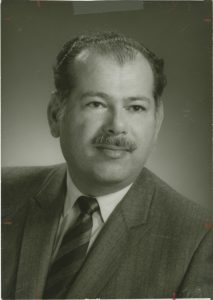(Nov. 26, 1929 – Jan. 5, 2010). Murray Saltzman was the youngest of three sons born to Russian immigrant parents in Brooklyn, New York. He first enrolled at Syracuse University before transferring to the University of Cincinnati, where he studied to become a rabbi. He was ordained in 1956 and later received a master’s degree in Hebrew letters from Hebrew Union College-Jewish Institute of Religion in Cincinnati.
From 1956 to 1958, Saltzman served as assistant rabbi at Congregation Emanu-El B’ne Jeshrun in Milwaukee. In 1958, he moved to Hagerstown, Maryland, and became the rabbi of Congregation B’nai Abraham. In 1962, he became rabbi at Temple Beth-El in Chappaqua, New York, for five years.
In 1964, Murray Saltzman was one of the 16 rabbis who answered the call put forth in a letter written by Dr. Martin Luther King Jr. to join his ongoing anti-segregation protest in St. Augustine, Florida. After protesting with King and getting arrested on June 18, 1964, the group of rabbis and one lay leader published a letter written in jail titled “Why We Went.” At the time, this event was the largest mass arrest of rabbis in American history. The arrests and their subsequent coverage galvanized organized Jewish support nationally for the civil rights movement.
Less than a year later, Saltzman was one of the rabbis who marched with Dr. Martin Luther King Jr. during King’s long march from Selma, Alabama, to Montgomery, Alabama, on March 21, 1965.
Saltzman then arrived at the in 1967, replacing Rabbi Maurice Davis, another notable civil rights activist. He would serve as IHC’s sixth rabbi in the congregation’s then 111-year history and continued in the role for 11 years until he was appointed senior rabbi at Baltimore Hebrew Congregation.
As a civic leader, Saltzman left his mark in Indianapolis and Baltimore. He joined as a cohost of Focus on Faith, which aired on from 1967 to 1972. Hudnut, then pastor of , and Saltzman shared their worry for human rights in general and Indianapolis in particular during the tensions surrounding the civil rights movement. He also instituted numerous social justice programs in both Indianapolis and later in Baltimore.
On November 1, 1974, President Gerald Ford nominated Saltzman as one of six members of the U.S. Commission on Civil Rights. He would hold his seat on the Commission from 1975 until 1983, when President Ronald Reagan aimed to replace Saltzman and two other liberal members whom President Ford had nominated with three conservative-leaning nominees during the Congressional Memorial Day recess. On October 25, 1983, Saltzman, along with members Mary Frances Berry and Blandina Ramirez, was dismissed from the Commission. The three members had sharply criticized President Reagan’s policies toward Blacks, women, and Latinos over the past two years. Berry and Ramirez successfully sued for reinstatement to the committee arguing that the entity was supposed to be nonpartisan. Saltzman refrained from joining the suit.
In recognition of his civil rights activism, Indiana governor Otis Bowen named Saltzman a Sagamore of the Wabash in 1977. Two years later, in 2019, Indiana Central College (now University of Indianapolis) awarded him an honorary doctorate of humane letters.
In 1996, Saltzman moved to Sanibel, Florida, and served as a part-time rabbi at Bat Yam Temple of the Islands. He died of pancreatic cancer at age 80 in Fort Myers, Florida.

Help improve this entry
Contribute information, offer corrections, suggest images.
You can also recommend new entries related to this topic.





